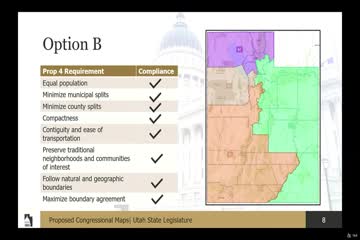Utah Redistricting Committee Discusses Prop 4 Compliance and Map Controversies
September 24, 2025 | 2025 Utah Legislature, Utah Legislature, Utah Legislative Branch, Utah
This article was created by AI summarizing key points discussed. AI makes mistakes, so for full details and context, please refer to the video of the full meeting. Please report any errors so we can fix them. Report an error »

In a recent meeting of the Legislative Redistricting Committee held on September 24, 2025, members engaged in a detailed discussion regarding the creation of new electoral maps in compliance with Proposition 4. This proposition mandates that partisan data cannot be used during the map-drawing process, a point emphasized by committee members throughout the session.
The committee reviewed five proposed maps generated from a pool of 6,000 computer-simulated options, which were narrowed down based on compliance with seven specific criteria outlined in Proposition 4. These criteria include preserving traditional neighborhoods and communities of interest, ensuring that the maps do not favor or disfavor any political party or incumbent, and maintaining partisan symmetry.
Co-chair Senator Jay Bridal clarified that while the maps were developed without any partisan influence, they underwent tests for partisan symmetry after their creation. This means that although the initial drawing of the maps was free from political data, subsequent evaluations were conducted to ensure fairness and compliance with the law. The results of these tests, which are publicly available, indicate that all proposed maps fell within acceptable ranges of partisan symmetry.
Committee members expressed the importance of transparency in the redistricting process, noting that while the tests were conducted, the specific partisan data used in evaluations was not disclosed to avoid any legal violations. This approach aims to uphold the integrity of the redistricting process while ensuring that the maps serve the community's interests.
As the committee moves forward, the focus remains on finalizing a map that meets both legal requirements and community needs. The discussions from this meeting highlight the ongoing efforts to balance fair representation with adherence to legal standards, a critical aspect of the electoral process in Utah.
The committee reviewed five proposed maps generated from a pool of 6,000 computer-simulated options, which were narrowed down based on compliance with seven specific criteria outlined in Proposition 4. These criteria include preserving traditional neighborhoods and communities of interest, ensuring that the maps do not favor or disfavor any political party or incumbent, and maintaining partisan symmetry.
Co-chair Senator Jay Bridal clarified that while the maps were developed without any partisan influence, they underwent tests for partisan symmetry after their creation. This means that although the initial drawing of the maps was free from political data, subsequent evaluations were conducted to ensure fairness and compliance with the law. The results of these tests, which are publicly available, indicate that all proposed maps fell within acceptable ranges of partisan symmetry.
Committee members expressed the importance of transparency in the redistricting process, noting that while the tests were conducted, the specific partisan data used in evaluations was not disclosed to avoid any legal violations. This approach aims to uphold the integrity of the redistricting process while ensuring that the maps serve the community's interests.
As the committee moves forward, the focus remains on finalizing a map that meets both legal requirements and community needs. The discussions from this meeting highlight the ongoing efforts to balance fair representation with adherence to legal standards, a critical aspect of the electoral process in Utah.
View full meeting
This article is based on a recent meeting—watch the full video and explore the complete transcript for deeper insights into the discussion.
View full meeting

